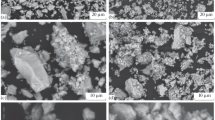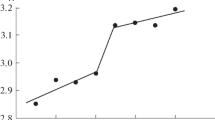Abstract
Ultrafine zirconia powders were prepared by a coprecipitation and spray-drying method. Agglomerates may be fragmented or present in green bodies after compaction. The effect of agglomerates on sintering and microstructural development was studied and it was found that the agglomerate content in compacts was a major factor affecting the microstructure development and the sintered densities. The interaction between agglomerates themselves, and between agglomerates and the primary particle matrix is discussed. It is argued that the hard agglomerates in the powder from the water-washed coprecipitates are formed by oxobridging between non-bridging hydroxyl groups present in the zirconium hydroxide structures due to the effect of hydrogen bonding in the aqueous system. The substitution of organic -OR groups for the non-bridging hydroxyl groups removes this hydrogen-bonding effect between the zirconium hydroxide units and thus eliminates the cause of agglomeration.
Similar content being viewed by others
References
G. C. Kuczyuski, N. A. Hooton and C. F. Gibson (Eds), “Sintering and Related Phenomena” (Gordon and Breach, New York, 1967).
G. C. Kuczyuski (Ed.), “Sintering and Related Phenomena”, Materials Science Research, Vol. 6 (Plenum Press, New York, 1973).
W. D. Kingery (Ed.), “Ceramic Fabrication Processes”, Part IV (Technology Press Cambridge, MA, Wiley, New York, 1958).
R. L. Coble, J. Appl. Phys. 32 (1961) 787.
D. E. Niesz and R. B. Bennett, in “Ceramic Processing Before Firing”, edited by G. Y. Onada Jr and L. L. Hench (Wiley, New York, 1978) pp. 63–71.
J. S. Reed, T. Carbone, C. Scott and S. Lukeriewisa, in “Processing of Crystalline Ceramics”, edited by H. Palmour III, R. F. Davis and T. M. Hare (Plenum, New York, 1987) pp. 171–180.
W. H. Rhodes, J. Amer. Ceram. Soc. 64 (1981) 19.
F. F. Lange, ibid. 65 (1982) 83.
J. L. Shi, J. H. Gao, Z. X. Lin and T. S. Yen, ibid. 74 (1991) 994.
F. F. Lange and M. Metcalf, ibid. 68 (1985) 369.
J. L. Shi, J. H. Gao and Z. X. Lin, J. Chinese Ceram. Soc. 17 (1989) 417.
J. L. Shi, PhD thesis, Shanghai Institute of Ceramics (1989).
S. L. Jones and C. J. Norman, J. Amer. Ceram. Soc. 71 (1988) C-1909.
M. J. Readey, R. R. Lee, J. W. Hallaran and A. H. Heuer, ibid. 72 (1990) 1499.
M. S. Kaliszewski and A. H. Heuer, ibid. 73 (1990) 504.
K. Haberko, Ceram. Int. 5 (1979) 148.
Author information
Authors and Affiliations
Rights and permissions
About this article
Cite this article
Shi, J.L., Gao, J.H., Lin, Z.X. et al. Effect of agglomerates in ZrO2 powder compacts on microstructural development. JOURNAL OF MATERIALS SCIENCE 28, 342–348 (1993). https://doi.org/10.1007/BF00357805
Received:
Accepted:
Issue Date:
DOI: https://doi.org/10.1007/BF00357805




